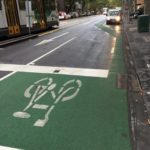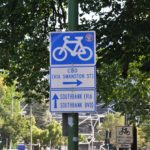The Transport Accident Commission (TAC) requested DTV Consultants to provide Dutch expertise to enhance cycling infrastructure and cyclists’ safety. Our main focus: the network of strategic cycling corridors in Melbourne, Geelong and Ballarat in Victoria, Australia. During a 2 week visit we reviewed more than 15 sites and held multiple design sessions with local designers as well as policy makers. Completed with 3 workshops in which more than 50 city council professionals and representatives of industry participated.
The coming years Transport Accident Commission (TAC) will invest significantly in cyclist infrastructure and improving cyclist’ safety. One of the strategies to reach these goals is the Safe Traffic System. To enhance the infrastructure design principles arising from this approach, Dutch expertise and practices on ‘sustainable safety’ principles are welcomed. Sustainable safety is a vision and way of working developed in The Netherlands in the early nineties. It is based on five principles: functionality, homogeneity, predictability, forgivingness, and state awareness.
Increase road safety for cyclists
Hafez Alavi from TAC explains. “As part of the ‘Safe System Road Infrastructure Programme (SSRIP)’ we allocate significant budgets to increase road safety of Victoria’s strategic cycling corridors. VicRoads’ offices and local councils were invited to submit projects for funding. We involved DTV Consultants’ expertise on safe system design alongside road safety of cyclists and pedestrians, to help us improve the designs prepared for submission to our programme. Involvement at this stage of the process helped designers to present better proposals. Meanwhile, it helped us increase the implementation’s effectiveness as well as the expected impact of our programme.”
Dutch cycling knowledge and experience
DTV Consultants’ methodology consists of on-site observations, reflection and discussion with policy makers and designers, followed by interactive design sessions leading to specific proposals directed toward enhancement of the design for selected strategic cycling corridors. The results and findings were consolidated, completed with Dutch design principles and examples before translating them into 3 workshops. The methodology is based on the Dutch safe system approach called Sustainable Road Safety and the Dutch Bicycle Design Manual. This manual is edited by DTV Consultants and published by the CROW institute.
- Local government in Australia called upon Dutch cycling expertise
- Dutch design principles for cycling infrastructure prove useful
- Cyclists need a clear place in infrastructural design
On-site reviews
Starting point for the on-site reviews was Melbourne’s Central Business District. This is an important junction, where multiple cycling corridors connect. The suburbs incorporated some attractive and well-designed solitary cycling paths, but in the CBD cyclists have limited space. A typical metropolitan, car-oriented grid structure, leaves little space for cyclists. 4×4 traffic lanes are no exception. Cyclists must settle for narrow lanes or share infrastructure with pedestrians. With representatives of VicRoads and city councils we reviewed a selection of bottle necks. These contained cycling corridors facing serious barriers, such as tramways, large arterial roads, rail infrastructure and even Jara-river.
After our visit to CBD, we visited other areas of Melbourne, VicRoads’s Melbourne offices North West and Southeast. Each visit required a structured approach: an introduction (to the projects at hand and explanation of the Dutch approach), on-site observation, discussion and reflection with local staff followed by suggestions and improvements to the design. In addition, visits and project reviews were conducted for Geelong and Ballarat.
Dutch infrastructure design principles applied
Because of involving DTV Consultants during the development phase of their SSRIP programme, TAC increased the quality of safety aspects for the project submissions. During the 2 week visit we reviewed more than 15 sites and held multiple design sessions with local designers as well as policy makers. In these sessions, staff members involved received direct hands-on reflection and coaching in cyclist infrastructure design inspired by the Dutch. In total, more than 50 city council professionals and representatives of industry participated in 3 workshops. In these, DTV Consultants shared their reflections and explained Dutch design principles. The message converted into five key points:
- Give cyclists a serious position in infra design
- Assess designs on the 5 design requirements
- Intersections: treat them Dutch style
- Midblocks: create sufficient width for cyclist infra
- Priorities: multiple priorities on corridors are no priorities
Next steps
Local designers and policy makers noted the observations, the proposals to improve the design of suggested projects and Dutch expertise provided in the workshops. Based on this VicRoads and city council’s staff finalised their project proposals and submitted them to SSRIP. Designs were enhanced with Dutch inspired treatments: separated paths and the Dutch intersection. In one specific case DTV Consultants’ ‘intervention’ motivated VicRoads staff to explore a cooperation with Monash University and Monash Medical Centre to enhance road safety of cyclists, students and staff of both institutes.
DTV Consultants’ also inspired TAC’s staff to follow further training about Dutch cyclist and pedestrian treatments for bot urban as rural areas. This resulted in a 2-day training session in Breda, The Netherlands.
About TAC
The Transport Accident Commission (TAC) enhances road safety in Victoria and supports those injured in traffic accidents. TAC’s work is financed by the revenues of vehicle taxes. TAC works on ‘no-fault liabillity’ base. Victims of a traffic accident receive medical support and / or financial compensation, regardless the cause of the accident.
Hubspot content can't be displayed because the use of tracking cookies is not permitted.


